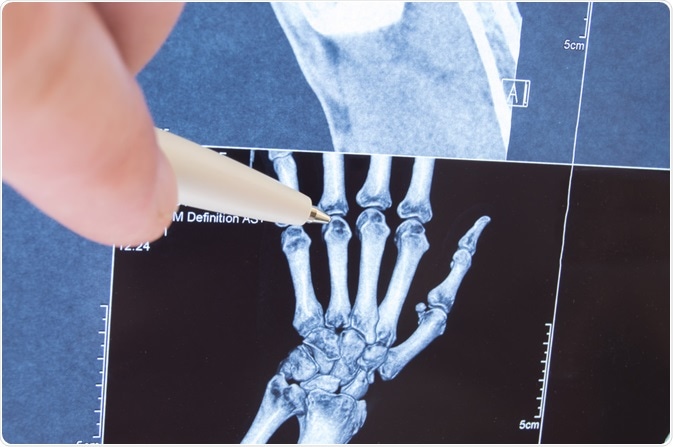Juvenile idiopathic arthritis (JIA) is the term given to a group of conditions that result in joint inflammation in children before the age of 16 years. JIA is an autoimmune condition caused by the formation of autoantibodies that target the synovial membranes of the affected joints. This is the most common rheumatic condition to affect children.

Image Credit: Shidlovski / Shutterstock.com
What is JIA?
JIA affects the synovial membranes of joints, leading to stiffness, pain, and restriction of movement of the swollen, red joint. As a result of these issues, the child may not be able to use the affected limb. In addition, fever and other systemic symptoms, including loss of weight and the appearance of a rash over the involved joint, are other possible clinical features of JIA.
JIA is a chronic condition that is characterized by periods of remission that alternate with flares. The chronic nature of this condition thereby carries with it the potential to cause several complications, along with those produced by the potent medications that are used to control it.
Joint complications of JIA
Over two-thirds of children with JIA continue to have joint and eye involvement in adult life. Joint pain can lead to a poor functional outcome over the long term. This means the child may be unable to participate freely in play, school activities, as well as in other social interactions. This could result in both psychological and physical distress.
Markers of future joint damage in JIA patients include:
- Severe arthritis within the first two years of onset, with initial involvement of more than 1 joint, involvement of at least one joint in the upper limb, or an ESR above 100 mm/hr predicted progression of joint destruction in pauciarticular forms
- Fever and multiple joint involvements within the first six months in the systemic forms
- Multiple joint involvements with positivity for rheumatoid factor predicted significant adult disability
- Sacroiliitis in psoriatic JIA patients who were male and HLA-B27-positive
- Involvement of the leg, especially the tarsals and the knee, predicted sacroiliitis in enthesitis-related JIA
Ocular complications of JIA
Uveitis is the term used to describe inflammation of the uvea, which is the middle layer of the eye. Moreover, uveitis, which has a remission rate of approximately 36%, is a long-term complication that is associated with cataracts, glaucoma, and band keratopathy.
Markers of other complications can include a family history of psoriasis in oligoarticular JIA that is associated with chronic uveitis, and secondary amyloidosis (4%) linked to systemic JIA.
Macrophage activation syndrome
Macrophage activation syndrome (MAS) is a feature of systemic JIA and may be present in an either clinical or subclinical form in almost all patients who have active forms of this subset of JIA.
MAS is considered an acquired variant of hemophagocytic lymphohistiocytosis. This condition is characterized by persistent fever, pancytopenia, coagulopathy, and organ dysfunction in the form of brain and liver deficits.
The presence of foamy macrophages and hemophagocytosis, the latter of which is a term used to describe the phagocytosis of blood cells by macrophages, is a distinctive feature on biopsy. Serum albumin is low, while ferritin, liver enzymes, and triglyceride levels usually go up.
MAS may occur as part of the rheumatic process or as a reaction to the use of some therapeutics, such as biologics. This condition may also arise as a response to an infection or a switch between drugs.
Other complications of JIA
Pulmonary complications, which are often fatal, may occur in over 80% of patients who have systemic JIA. Symptoms include shortness of breath, dyspnea on exertion, clubbing, and cough.
The pulmonary manifestations mainly include pulmonary arterial hypertension (64%), interstitial lung disease (28%), alveolar proteinosis (20%), and lipoid pneumonia. Complications like pleuritis, pericarditis, and growth failure can also ensue.
Complications due to treatment mainly encompass three broad categories:
- Steroid-associated complications (osteoporosis in 40% of cases, pathologic fractures in 8% of cases, cataracts in 24% of cases, avascular necrosis in 12% of cases, and a propensity for serious infections)
- Drug-related toxicity (liver and bone marrow suppression, oral ulcerations, and infections)
- Biologics-related toxicity (immunosuppression leading to reactivation of tuberculosis and other infections, demyelinating disease, drug-induced lupus, and leukocytoclastic vasculitis)
Infections may occur during the course of the disease or while the patient is being treated with immunosuppressive drugs or steroids. The most severe infections that can develop include sepsis, salmonella, and adenoviral gastroenteritis, pneumonia, Clostridium difficile enteritis, typhilits, and ascariasis.
Potential rare complications of JIA include psychosis, myositis, transient ischemic attack, thrombotic thrombocytopenic purpura (TTP), and dyslipidemia. Also, it must be emphasized that children with JIA have a higher rate of developing cancer.
In terms of mortality, the risk of death is highest in systemic JIA, mostly due to the presence of MAS and infections. Nevertheless, the current use of biologics has led to an improvement in both the short- and long-term prognosis of this condition.
References
Further Reading